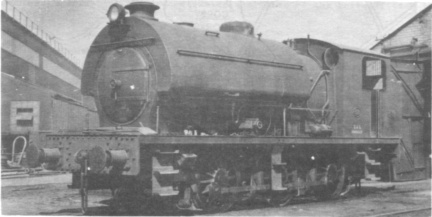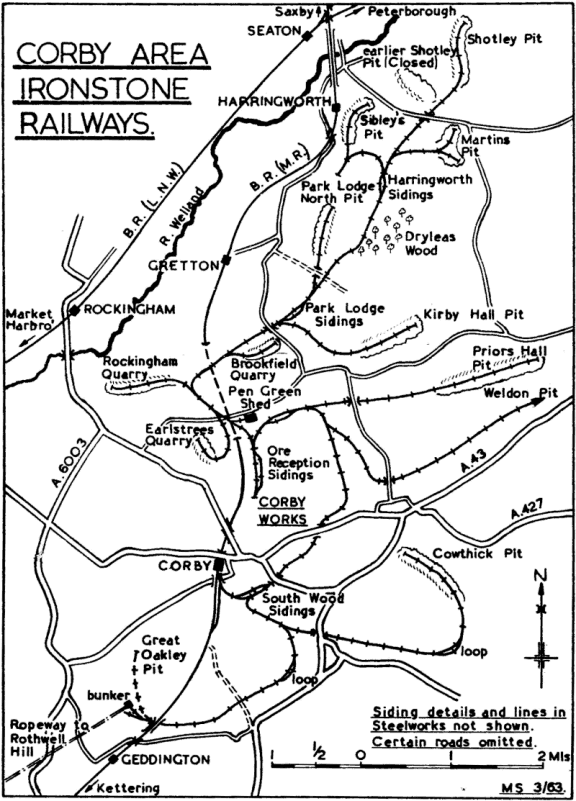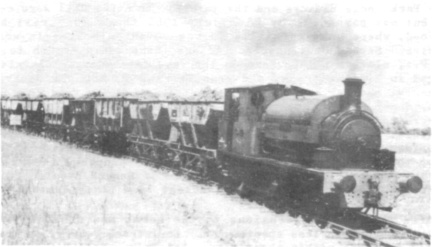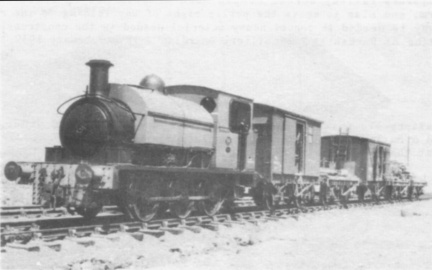
| THE INDUSTRIAL RAILWAY RECORD |
© JULY 1963 |
IRONSTONE TRAMWAYS
OF THE MIDLANDS
| (2) EXPANSION AT CORBY |
by ERIC S. TONKS |
For the past few years most ironstone quarries have been faced with reduced demand, and though extensions to fresh quarrying areas form an essential part of their existence these have recently been restricted by prevailing circumstances. The closure of the smaller ironworks at Cransley, Kettering, Sheepbridge, and - more recently - Holwell and Wellingborough, have all had their effect and most of the larger quarry systems have idle pits. Even Corby has suffered to some extent, but the concentration of ironmaking here has kept up a steady demand for ore and extensions have been made in all the compass points.
The most spectacular expansion since 1958 has been to the south of Corby Works. A line was laid from a junction at South Wood Sidings to Cowthick Pit, adjoining the A 43 road from Weldon to Geddington, and since 1960 this pit has been worked with the aid of a W 1400 dragline, bigger than the one at Priors Hall Pit. An even more ambitious scheme involved the construction of a branch from the Cowthick line in the Oakley direction, the immediate objective of which was to collect ore sent by aerial ropeway from the Rothwell Hill Quarries, reopened in December 1959 after lying dormant for thirty-three years. In their earlier period of activity these were served by a narrow gauge tramway to Desborough on the Midland mainline, involving two cable-operated inclines. The present scheme utilises lorry transport between pitface and the loading bunkers of the ropeway on the site of the old West Face at Rothwell Hill Quarry. Thence the ropeway runs five miles in a straight line across country to Great Oakley.

A "56" class locomotive outside the shed in Corby Works on 1st July 1951, prior to the opening of Pen Green shed in August 1954. No.58 - Robert Stephenson & Hawthorns Ltd. 7669 of 1950 (L.W. Perkins)

It is a bi-cable system, and each of the 124 hods holds seventeen cwts. of ore. Normally a hod arrives at the unloading point every twenty-six seconds, having taken fifty-three minutes on the journey. The ropeway crosses a number of roads en route and elaborate precautions are taken to prevent spillage on the roads; and should anyone venture on to these bridges, a tripwire immediately stops the mechanism, the bridge concerned being indicated on a recording panel at Great Oakley. So sensitive is the tripwire that a pheasant settling down has been known to activate it! Near Triangular Lodge at Rushton Hall (an Ancient Monument worth a roadside stop to see) the ropeway crosses the furthest of the Desborough Warren workings (now closed) and instructions were given, apparently ignored in the main, that working beneath the cable should cease when the latter was in motion.
At the Great Oakley end the hods are emptied into bunkers straddling a siding into which standard ore tipplers are run by gravity. A locomotive, nearly always of the "56" class, brings in a train of up to twenty empties, places then above the bunkers, and then returns to the other end of the sidings to take water and coal. After the crew have contacted Control by lineside telephone for clearance, the "56" backs on to the full train for the journey to Corby. The track is first class but the going hard, as the grade is against the load most of the way with lengthy stretches of 1 in 70 and 1 in 93. At the commencement of the journey, a 10 m.p.h. restriction is in force under the Geddington Viaduct, and beyond that the engine has to work hard for nearly all the seven miles to the ore reception sidings north of Corby Works, making a wide circuit of the Works to the south and east in doing so. Considerable track alterations have been made in the vicinity of the Works to accommodate extensions, and further deviations nay be required. (Incidentally, ore trains from all other Corby area quarries come to these reception sidings.) The "56" class locomotives are masters of the situation, however, and on a footplate trip Mr Starmer and the writer were permitted to enjoy, pressure never fell below 160 lbs., a credit to the free-steaming qualities of the boiler fitted to this class.

45 COLWYN (Kitson 5470 of 1933) with a loaded train from Sibley's Pit on 25th July 1962. (G.H. Starmer)
A rough bridle road, known as Featherbed Lane, between Corby and Little Oakley is crossed on the level, on an ascending grade from the terminus, and warning is given both by a whistle from the engine, and a pneumatically operated siren. The latter stands at the (unprotected) crossing and sounds as the locomotive wheels pass over a trackside contact about two hundred yards away. In the summer of 1962 there were three, sometimes four, trips daily between Corby Works and the ropeway terminal, but the lime will shortly enjoy greater utilisation. A branch is being put in just west of Geddington Viaduct to serve a fresh quarrying area at Great Oakley, north of the terminal, where a W 1800 dragline - even bigger than the Cowthick machine - is being assembled.
Let us now have a look at developments to the north of Corby Works. On emerging from Corby tunnel the Midland line hugs the middle of the slope of the Oolitic Cliff as far as Harringworth, thence heading across the Welland valley, while the London & North Western line to Peterborough also crosses to the south side of the Welland here. This convenient rail access has facilitated development of the ironstone occurring on the high ground of the Cliff, and four individual tramways were opened at various times, as we know, at Corby, Gretton, Harringworth and Wakerley. The rail traveller can see faint traces of the old incline at Gretton, and more substantial remains at Harringworth. At Wakerley, Mr T.C. Smith reported in March 1959 that some of the former working area had been reclaimed for farming land but that the kilns were still standing. The passenger might also see the jibs of draglines and excavators on the skyline here and there, but Stewart & Lloyd’s northern extension from Corby is invisible beyond the top of the Cliff. It is, however, steadily being pushed forward and is gradually unifying the whole of the workable area. Gretton has been by-passed, Harringworth engulfed, and Wakerley threatened.
Harringworth Sidings (at the junction of the branch to Park Lodge North and Sibley’s Pits) and Park Lodge Sidings have both been remodelled, and it is planned to double the section between and install colour light signals throughout. (Formerly Park Lodge Sidings and the junction to Kirby Hall were controlled by signals, but not beyond.) By 25th July 1962 the second rail had reached Dryleas Wood, where Manning Wardle 33 was noted on a platelayers’ train of ten vehicles. Beyond Harringworth Sidings there was a branch to the east to Martin’s Pit, closed in 1962, and on the same date another platelayers’ train was engaged in lifting track, and transferring it and the excavator to the newest quarry, Shotley Pit. This is located beyond the road from Harringworth to Laxton, under which the tramway was extended late in 1961. There were earlier workings at Shotley, part of the course of the tramway to which is still visible. Indeed, even in narrow gauge days, there were quarries here and the bridge under the road still survives. The new Shotley Pit lies at the end of the former quarrying area, and it is proposed to extend the line further east - possibly as far as Wakerley - if demand require it, though the further workings may depend on lorry haulage to a rail terminal chute.
Compared with these extensions to the north and south, other orefield developments have been less spectacular. Earlstrees Quarry, on the west side, is expected to close within three years, but Priors Hall Pit has been extended so that the north and south approach limes now meet. However, the latter is not worked in a circular fashion, and trains entering by the northern route leave that way too.
On the locomotive side there have been a few changes. A further, and probably final, example of the highly successful "56" class arrived in October 1958 (numbered 64; Robert Stephenson & Hawthorns Ltd. no.8052). Nowadays, Glendon East is virtually a "subshed" (to use British Railways terminology) of Pen Green and exchanges have occurred from time to time. 44 was loaned to Corby Works in February 1961, and 42 similarly about December 1961. Both were returned, dirty and uncared-for, in June 1962, to the despair of Mr Bates, Locomotive Superintendent at Pen Green, who justifiably claims to have "the cleanest locomotive stock in the British Isles". The quarry engines are now all in a standard livery of light green, with red coupling rods, and black lines behind handrails and on edges of the cabs - "handleable" parts, in fact. To visit the shed at the end of the day’s work and see them all, polished and gleaming, is a treat, nothing less.
As only to be expected in a large organisation, diesel power has been considered, and a Yorkshire Engine Company 0-8-0 diesel-hydraulic of the "Taurus" class was one locomotive that cane on trial. A locomotive of the same type, but of the "Indus" class, (Yorkshire Engine Company no. 2894), arrived during the summer of 1962, but carries no running number as yet. As a result, and for the first tine since 1951, two steam engines have been sent "north of the Welland" - 42 to Harlaxton, and 60 to Market Overton. One of the Works locomotives, 12, was converted to burn oil fuel in the spring of 1962 and, when freshly resplendent in the standard Works livery of buttercup yellow with black diagonal bands and red rods, was loaned to Pen Green for a week’s trials, in exchange for 63.

35 (Manning Wardle 1317 of 1895) with a permanent way train on the "main line" south of Shotley Pit on 25th July 1962. (G.H. Starmer)
Wagons are now exclusively 20- or 30-ton tipplers. The last use for hoppers was to transport ore to Wellingborough Ironworks, which traffic has now, of course, ceased. An old "dumpcar" frame has been converted at Pen Green for use as a snowplough, and we imagine it has seen plenty of use this winter.... Further rail developments at Corby may confidently be expected, and we shall watch events with interest.
This article has been made possible by the generous help of Mr R. R. Willock, General Manager, and Mr Perrell, Traffic Manager, of Stewarts & Lloyds Minerals Ltd., Corby; to Messrs. J. L. Hobson and G. H. Starmer; and the observations of several members.
For the record . . . .
"Blyth Town Council has approved a scheme by the Cowpen Coal Co. Ltd. to lay a temporary railway across Cowpen Road between Cowpen Cemetery and the North Farm, and also to cross the public right of way leading to the riverside. The railway is needed to convey heavy material needed in the construction of new coal staiths at Buckshill." ("Colliery Guardian", 19th February 1932.) (K.P.P.)
"A battery-electric locomotive has just been installed underground by Greenwood & Batley Ltd. at the Aitken colliery of The Fife Coal Co. Ltd. It is thought that it is the first British locomotive to be introduced into a mine."
("Colliery Guardian", 1st January 1932) (K.P.P.)
"By reconstructing a bridge over 400 feet long and 80 feet high over the Wansbeck, the Cowpen Coal Co. Ltd. are able to reduce the carrying distance of coal from their North Seaton colliery to their loading spouts at North Blyth by about 2½ miles. The coal was previously taken by the L.N.E. Railway."
("Colliery Guardian", 27th February 1931.) (K.P.P.)